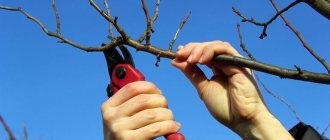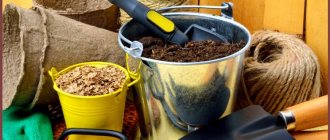The correct choice of place for planting them and further competent care are the key conditions for success in growing climbing roses!
- How to choose the right place to plant a climbing rose
- What soils do climbing roses prefer?
- Timing for planting climbing roses My personal experience of transplanting an adult rose bush
- My personal experience in watering climbing roses
- Small-flowered climbing roses
- My personal experience with gartering large-flowered roses
- My personal experience in covering large-climbing roses
What soils do climbing roses prefer?
Climbing roses prefer cultivated, humus-rich and breathable soils. If the soil on the site is moist and prone to stagnant water, plant them in a raised bed. In principle, this recommendation applies to everyone; raised beds are warmer and easier to care for.
It is better to prepare the landing site in advance. Roses prefer slightly acidic (pH 5.5–6.5) soils. On more acidic soils, when cultivating, add 500 g of lime per 1 m2. Before planting, add 3-4 buckets per 1 m2 of rotted manure, humus or compost to the entire depth of the treated layer. You can add clean sand.
Personal experience: climbing rose variety Ilse . The variety of this climbing rose is valued for its remontability.
Planting dates for climbing roses
By the end of August, plant climbing rose seedlings sold in containers. They take root well and overwinter in open ground. In August or July (in case of cool summers), mature bushes can be replanted if necessary.
My personal experience of transplanting an adult rose bush
I have already moved my bushes of large-flowered and small-flowered roses to a new place many times. At the same time, the time of transplantation occurred in both spring and autumn. In any case, the roses took root. The key to good survival of a climbing rose after transplantation is heavy pruning of the bush! Don't be afraid, the roses will recover in just a couple of years and even with pruning they will rejuvenate and bloom better.
I personally did not use any Kornevins or Epins during transplantation; there were no problems anyway. Perhaps for more capricious varieties, which are not in my small collection, they will be needed.
And of course, if possible, replant with a large lump of earth. After replanting, the bushes can even be slightly deeper compared to the previous planting, but not much.
Covering flowers for the winter
For regions with mild winters
There are no difficulties with insulating roses in such a climate. In varieties with long shoots, the stems are bent and fixed to the ground (as an option - with small staples). If a rose develops on a support (for example, arched), then the branches are “fastened” directly to its elements. All that remains is to cover it with spruce branches or appropriate insulation material.
It’s even easier with low-growing flower species. If the height of the bush is small (after pruning), it is enough to cover it with a cardboard box and cover it with shavings, sawdust, humus, peat or pine needles. The choice of options is impressive. The main thing is to ensure that, if necessary, it is possible to carry out high-quality ventilation of the space under the “dome” to prevent damping off of the climbing rose.
Literally any mulch is not suitable for such a lightweight method of covering a climbing rose. There are often recommendations for using straw, old leaves, tops or something similar. This should not be done because small rodents like to nest in the same foliage or grass for the winter. In addition, it is not a fact that there are no garden pests on the “greenery” removed from the territory. In principle, it should not be on the site, since all plant debris must be immediately burned.
Optimal distance between climbing rose bushes
Climbing roses grow quickly, so plant them 1-1.5 m apart (if planted in a row). Of course, in most recommendations you will find a distance significantly greater than this figure. These recommendations are suitable for the southern regions of our country. But if you want to get real pink scenes in the Moscow region, plant roses closer.
My personal experience in growing climbing roses
Today I have 2 bushes growing on a plot approximately 4 meters long. BUT! These two bushes have long been actually 10 different rose bushes, resulting from 2 mother plants planted initially. I achieved this gradually and purposefully, so that if the bush died, the flower garden would not be empty and there would still be roses left on it.
WATCH THE VIDEO WITH MY FAVORITE ROSE:
To do this, every year for several years in the fall I added soil to the root of the bush and slightly moved the soft branches to the sides (by laying them down for the winter). In the spring, I raked away the soil, but not completely - I partially left these branches covered. And now I additionally make layering from the climbing rose to the sides along the bed. This provides a constant supply of planting material for friends and neighbors and increases the number of growing points for the climbing rose in my own garden bed.
Personal experience: variety of low climbing rose Eric Tabarly . I grow it as a shrub, but I haven’t been able to grow it as a wicker plant, despite its advanced age. I changed seats a couple of times, but the new location did not change the situation.
Tips for performing the procedure
Before the procedure, all instruments must be cleaned of rust and sharpened well. Cuts on the vines should not be torn: this will cause pain to the bush and slow down its growth. Tools are disinfected with potassium permanganate so that dangerous fungal spores do not get into the cut areas. Each cut site is treated with a prophylactic solution. This could be potassium permanganate, copper sulfate, wood ash, activated carbon or garden pitch.
On a note!
Garden varnish is prepared on the basis of yellow wax.
How to properly water climbing roses. When and how much water do they need?
Roses love abundant watering, especially large-flowered climbing roses require a lot of water. It is better to water the bushes rarely, but abundantly (up to 25 liters of water per adult climbing rose bush). By the end of summer, reduce watering of roses to a minimum.
My personal experience in watering climbing roses
I water roses, as a rule, in the evening at the root with water from a hose from the public water supply system. The main thing here is to water not on the leaves, i.e. Give up irrigation by sprinkling immediately and forever.
Personal experience: rose variety Polka 91 is a low climber. Quite stable, blooms profusely.
Preparing for shelter
Before covering roses for the winter, a number of activities are carried out to prepare them. Whether the bushes can survive even a very cold winter depends on their correct implementation and good shelter.
Top dressing
Preparation of climbing roses for winter begins in August - early September. During this period, when feeding, potassium-phosphorus fertilizers are introduced and nitrogen-containing fertilizers are excluded.
For greater effect, fertilizers are introduced both at the root and when spraying the bushes with a spray bottle.
Before feeding, the climbing rose is watered abundantly. Moisture-charging watering is the final session of irrigating bushes this year. 2 buckets of water are poured onto a small bush, and 3-4 buckets onto an adult bush 2-3.5 meters high.
Per one rose bush, 40-60 grams of superphosphate, 15-20 grams of potassium salt or 200 grams of wood ash are added for a young plant and 400 grams for an adult bush.
This fertilizing accelerates the lignification of wood and prevents the growth of new shoots.
Treatment against pests and diseases
Treatment of bushes from pests and diseases is carried out after the pruning procedure.
After the leaves have been removed from the bushes and the plants have been pruned, the roses are sprayed with preventive agents against pests and diseases.
To protect rose bushes from pests, the soil under the bushes is cleared of weeds and debris and dug up to the depth of a shovel.
The bushes and soil are treated with a solution of Actellik, Fitoferma, Fufanon.
To protect against diseases, drugs such as Milanit, Paracelsus, Kevlar, Absolute, Carbon, Block or iron sulfate are used (300 grams of the drug per bucket of water).
Do I need to trim?
Climbing roses grow in adulthood and reach quite large sizes, and covering them for the winter causes a lot of inconvenience, especially if the plant is very thorny. To make covering easier, roses are pruned.
Climbing roses are usually pruned to 1/3 of their height. In addition, old, darkened, immature and broken shoots are removed from the bushes. Thick woody stems are cut with pruning shears at a height of 1.2 meters above the ground.
When pruning, the correct direction of growth is formed, suitable for a support or arch.
When and how to prune roses in the fall
Bending, pruning and covering climbing roses for the winter: video
When, how much and what kind of fertilizer should be applied to climbing roses
Climbing roses are quite large plants, and they require appropriate nutrition. In the first year after planting a climbing rose, if the basic planting rules are observed (planting pit filled with organic matter, mulching), the bushes do not need to be fed. During the season, roses are fed 4-5 times. The first time - immediately after spring pruning, in the stage of swelling of the buds (organic and mineral fertilizers at the rate of 150–200 g and 50 g per 1 m2, respectively). Next, at the beginning of shoot growth (organic with mineral water, the main elements are phosphorus and potassium), the third - during the budding period and the fourth - after the first flowering with a complete complex fertilizer with microelements.
The last feeding of twice-blooming climbing roses is carried out after the second flowering, using mineral fertilizer with potassium and a minimum nitrogen content. At the same time, be careful: excessive application of fertilizer can cause rapid growth of shoots that will not have time to ripen by winter.
My personal experience in feeding climbing roses
I don’t bother with feeding roses at all. If possible, I constantly add humus and compost, especially in the fall to the roots for greater winter hardiness. From spring to July I add complex mineral fertilizers, first with a predominance of nitrogen, then phosphorus and potassium. I sprinkle all the fertilizers by eye: I scatter them over the garden bed, loosen them and spill them with water.
When to prune
When considering the pruning process, it should be mentioned that climbing roses can bloom on last year’s or young branches. This is the main condition that is taken into account when caring for a plant. Ramblers produce color only on last year's branches, so they are pruned in the fall after the vegetative cycle has completed with flowering. Dry inflorescences must be removed.
Climbers bloom on young branches that are no more than 1 year old, so pruning is recommended in early spring after the air temperature during the day and night stays at around +2 degrees. Pruning at a time when night frost is possible is unacceptable, the frost will “grab” the cuts and they will not produce growth and flowers. An equally dangerous problem is rot, which is formed as a result of fungal infection, therefore, after formation, the plant must be treated with a fungicide.
Features of pruning small-flowered and large-flowered climbing roses
In the spring, after the roses open, remove all damaged shoots. In summer, prune to control flowering. It is necessary to trim faded flowers to the first well-developed bud and remove blind (without buds) shoots, leaving 2-3 well-developed five-leaf leaves on each.
Small-flowered climbing roses
Small-flowered roses bloom once along the entire length of overwintered shoots. Therefore, carry out the main pruning in the fall, leaving 5–7 of the strongest annual shoots on the bush. Cut the rest down to the base. In the spring, the shoots are only slightly shortened (cutting off 10–20 cm at the very top) and poorly overwintered shoots are removed.
Personal experience: You can get almost anything from a small-flowered rose: you can lift it to the top and you will get a classic climbing rose on a support, or you can leave it at the bottom and make a ground cover out of it. My rose has gone through many guises in her life. It looked very beautiful as a ground cover rose, with the bottom decorated with white Arends saxifrage. Their flowering does not match, but they still look very beautiful together.
Large-flowered climbing roses
Large-flowered roses form powerful shoots on which lateral flowering branches grow. Flowers are formed on shoots of the 2nd order. In the spring, carry out sanitary pruning: cut out all damaged shoots. Form a large-flowered rose after flowering: cut out all old (over 3 years old) shoots, small branches that will not bear flowers, and weak ones. Leave only long, healthy young shoots. In September-October, cut out all weak and unripe ones.
Standard climbing roses
Standard small-flowered roses are pruned, forming a harmonious weeping crown in accordance with the requirements of the garden group to which the grafted variety belongs.
My personal experience in pruning large-flowered and small-flowered roses
The main thing I do with roses is to constantly prune them, or rather 3 times a year:
I prune roses for the first time in the spring : I use pruning shears to remove all the shoots that are damaged and died during the winter;
This is the second time I prune roses after flowering: this is the most important pruning of the year. At this point I am shaping the roses for next year. I cut off all shoots older than 3 years. I leave only young, even and strong shoots with bright green bark. I trim the remaining flowers to 70%;
I prune roses for the third time in the fall, in October-November - I remove unripe shoots and trim them that are too long and cannot be placed under cover.
Necessary equipment for pruning
For pruning you need the following set of tools and devices:
- pruners of different sizes and strengths - for large, old branches you need a massive one;
- folding saw, with the ability to change the angle of the blade;
- pruning shears with one cutting end;
- Teflon gloves (long);
- folding rakes.
For convenience, you can buy knee pads. They are made from different materials. They can be called an indispensable thing for working in the garden.
Secateurs of different sizes are necessary for accurate work. It is difficult to grab and cut without damaging a large branch with a small device. Working with young shoots requires caution, so it is better to use pruners with a thin blade.
Garter to the support of a climbing rose
Climbing roses need support, otherwise you will end up with a huge ground cover bush. And if this is in principle possible to do with ramblers, then large-flowered ones must be raised. The support must be strong enough to support the weight of the rose. The shoots are tied up in early May and removed from the support in October.
My personal experience with gartering large-flowered roses
Over the long history of growing large-flowered roses, I have tried different support systems: these were ready-made self-assembled structures, hand-knocked wooden trellises, etc. And now I’m ready to share my own secret method for gartering climbing roses.
The secret of my support is simple! For the base, I used ready-made metal posts for an ordinary country fence. These posts are sold at every gardening or construction market. I have 3 pillars dug in for a length of 4 m, painted green. Such ready-made poles always have special welded ears for attaching bars, onto which boards are then nailed. So, every spring we attach a wooden lattice to these ears and remove it every fall. Three people do this: two hold the grille and the rose, the third screws or unscrews the grille with a screwdriver.
Our bars are at least 5 years old; for the winter we put them behind the barn, where they hang on the wall under the roof. In summer they keep a rose. The fact that the trellis is removable makes it much easier for us to winterize and lift the rose. When the grate is removed, the rose itself falls under its own weight onto the lawn. And in the spring, the rose is immediately placed on a support, and there is practically no need to tie up the lashes - only those that are trying to run away to the side.
Caring for bushes after pruning
How to mulch roses - which mulch is better
Autumn work on caring for rose bushes is not limited to pruning. These include:
- applying phosphorus-potassium fertilizers, which help the shoots to ripen;
- removing faded flowers;
- pinching young shoots;
- burning or adding to compost the green mass left after cutting plants;
- processing of cuts with garden varnish or a specialized paste;
- removing leaves before constructing a shelter to prevent the appearance of rot.
Rose is one of the most beautiful garden plants. To help it adequately withstand the tests of frost in winter, it is important to properly cut off its shoots, as well as carry out other autumn care measures.
Peculiarities of propagation of climbing roses
Most large-climbing roses are very difficult to propagate by cuttings, but easy to propagate by layering. In June, take a mature but flexible shoot of a climbing rose aside and partially bury it. After 2 seasons, you will receive a well-rooted rose, which you can separate from the mother bush and transplant to a new place or simply give to friends.
If you need to get a bush by next spring, then before burying the shoot, make a 5–8 cm long cut on its lower part and insert a match into it.
You can do the same with a small-climbing rose; this is one of the simplest methods that gives a very good result.
My personal experience in propagating large-flowered and small-flowered roses
Exactly repeats the one described above, however, I don’t bother with matches. I just do 2-3 layerings every year in June. I distribute the roses allocated 2 years ago in the spring. All friends and neighbors are already gifted. It was also possible to propagate a large-climbing rose from a cutting, but there are much more problems, which means there is no point in getting involved. Although the climbing rose from cuttings, of course, also grows on my site and feels great.
Characteristics of climbing roses
Climbing roses are divided into three main groups:
- ramblers. Their shoots are flexible, green, the inflorescences are small, with terry petals. Flowers appear on last year's shoots. Famous ramblers include Santana, Laguna and Flame Dance;
- hybrid varieties. They were obtained by crossing remontant and bush roses. The shoots of hybrids are strong and elastic, becoming woody over time. The flowers are large, collected in racemose inflorescences. Inflorescences can be seen on any shoots, regardless of the year of growth. Hybrids include roses from the Wilhelm Cordes nursery, as well as Sympathy, Polka and the Utersen variety;
- mutagenic or bush roses (climbings). They grow quickly, turning into a picturesque shrub. In Russia, such varieties as Golden Perfume, Mir, Alokh and Elven Rose are popular.
Important! Pruning patterns for climbing roses are different and depend on the variety.











